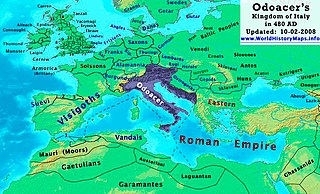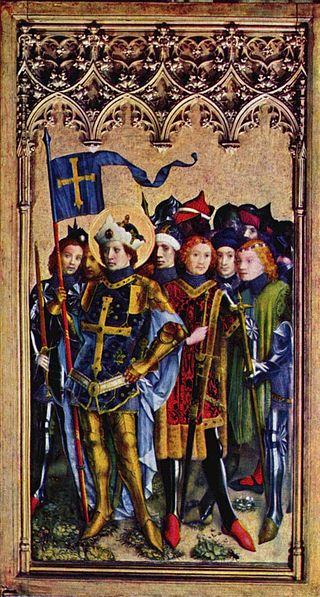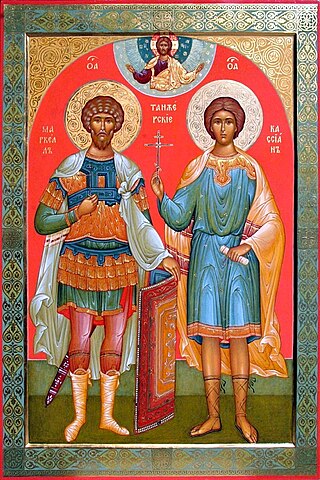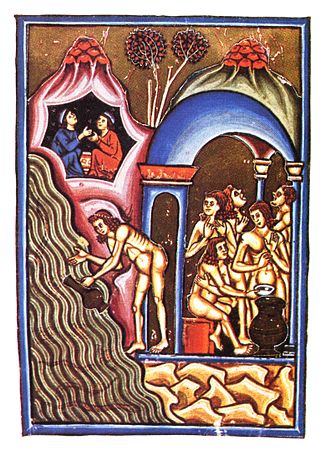Related Research Articles

Year 480 (CDLXXX) was a leap year starting on Tuesday of the Julian calendar. At the time, it was known as the Year of the Consulship of Basilius without colleague. The denomination 480 for this year has been used since the early medieval period, when the Anno Domini calendar era became the prevalent method in Europe for naming years.
The 480s decade ran from January 1, 480, to December 31, 489.

Germanus of Auxerre was a western Roman clergyman who was bishop of Autissiodorum in Late Antique Gaul. He abandoned a career as a high-ranking government official to devote his formidable energy towards the promotion of the church and the protection of his "flock" in dangerous times, personally confronting, for instance, the barbarian king "Goar". In Britain he is best remembered for his journey to combat Pelagianism in or around 429 AD, and the records of this visit provide valuable information on the state of post-Roman British society. He also played an important part in the establishment and promotion of the Cult of Saint Alban. The saint was said to have revealed the story of his martyrdom to Germanus in a dream or holy vision, and Germanus ordered this to be written down for public display. Germanus is venerated as a saint in both the Roman Catholic and Orthodox churches, which commemorate him on 31 July.
Constantius may refer to:

Genevieve is the patroness saint of Paris in the Catholic and Orthodox traditions. Her feast is on 3 January.
Elafius, alternately Elaphus and Elasius, was recorded as a British figure of the fifth century AD. Elafius is the name used by Bede, however, the best texts of Constantius of Lyon record the name as Elaphus and Elafus.

The Theban Legion figures in Christian hagiography as a Roman legion from Egypt—"six thousand six hundred and sixty-six men"— Christians who were martyred together in 286, according to the hagiographies of Maurice, the chief among the Legion's saints. Their feast day is held on September 22.

Saint Cadoc or Cadog was a 5th–6th-century Abbot of Llancarfan, near Cowbridge in Glamorgan, Wales, a monastery famous from the era of the British church as a centre of learning, where Illtud spent the first period of his religious life under Cadoc's tutelage. Cadoc is credited with the establishment of many churches in Cornwall, Brittany, Dyfed and Scotland. He is known as Cattwg Ddoeth, "the Wise", and a large collection of his maxims and moral sayings were included in Volume III of the Myvyrian Archaiology. He is listed in the 2004 edition of the Roman Martyrology under 21 September. His Norman-era "Life" is a hagiography of importance to the case for the historicity of Arthur as one of seven saints' lives that mention Arthur independently of Geoffrey of Monmouth's Historia Regum Britanniae.

Saint Alban is venerated as the first-recorded British Christian martyr, for which reason he is considered to be the British protomartyr. Along with fellow Saints Julius and Aaron, Alban is one of three named martyrs recorded at an early date from Roman Britain. He is traditionally believed to have been beheaded in Verulamium sometime during the 3rd or 4th century, and his cult has been celebrated there since ancient times.

Saint Randoald was prior of the Benedictine Moutier-Grandval Abbey under Germanus of Granfelden. He is recognised as a saint in the Catholic and Eastern Orthodox Churches

Saint Marcellus of Tangier or Saint Marcellus the Centurion was a Roman centurion who is today venerated as a martyr-saint in both the Eastern Orthodox and the Roman Catholic Churches. His feast day is celebrated on October 30.
Muirchú moccu Machtheni, usually known simply as Muirchú, was a monk and historian from Leinster. He wrote the Vita sancti Patricii, known in English as The Life of Saint Patrick, one of the first accounts of the fifth-century saint, and which credits Patrick with the conversion of Ireland in advance of the spread of monasticism. This work was dedicated to Bishop Aedh of Slébte, who was also the one who suggested the biography be written, and was the patron for the work. Muirchú's work is of little historical value in relation to the distant fifth century, but is a useful source for the time in which he lived and how Patrick was viewed in the seventh century.
Heiric of Auxerre (841–876) was a French Benedictine theologian and writer. An oblate of the abbey of Saint-Germain d'Auxerre, he studied with Lupus Servatus and Haimo of Auxerre. His own students included Remigius of Auxerre and Hucbald. His Miracula sancti Germani was a verse life of St. Germanus. Other works include his Collectaeum, a homiliary, and glosses on the Categoriae decem.

Saint Germanus of Granfelden was the first abbot of Moutier-Grandval Abbey. He is venerated as a martyr saint in the Catholic and Eastern Orthodox Churches.

Desiderius of Vienne was a martyred archbishop of Vienne and a chronicler.

The Vita Germani is a hagiographic text written by Constantius of Lyon in the 5th century AD. It is one of the first hagiographic texts written in Western Europe, and is an important resource for historians studying the origins of saintly veneration and the "cult of saints." It recounts the life and acts of bishop Germanus of Auxerre, who travelled to Britain c. 429 AD, and is the principal source of details about his life. It is one of the few surviving texts from the 5th century with information about Britain and the Pelagian controversy, and is also one of the first texts to identify and promote the cult of Saint Alban.
The Passio Albani, or Passion of Saint Alban, is medieval hagiographic text about the martyrdom of Saint Alban, the protomartyr of Roman Britain. The author is anonymous, but the work is thought to have been written in the sixth or fifth century. In the latter case, it may actually have been authored or commissioned by Germanus of Auxerre. It currently survives in three different recensions and six separate manuscripts located throughout Europe, and forms the basis for all subsequent retellings of the Saint Alban martyrdom, from Gildas to Bede.
Patiens of Lyon was bishop of Lyon in the 5th century and recognized as a saint by the Roman Catholic Church. He succeeded Bishop Eucherius, and died on September 11 before 494, the year in which his second successor Rusticius began his episcopate.
Germani may refer to

Germanus was the bishop of Capua from 519 or shortly before until his death. He played a major role in bringing to an end the Acacian schism, the first major schism that divided the Christian church between east and west.
References
- ↑ Garcia, Michael. "Saint Alban and the Cult of Saints in Late Antique Britain" . Retrieved 19 November 2014.
- "Constantius of Lyon - de Vita sancta Germani". Vortigern Studies.